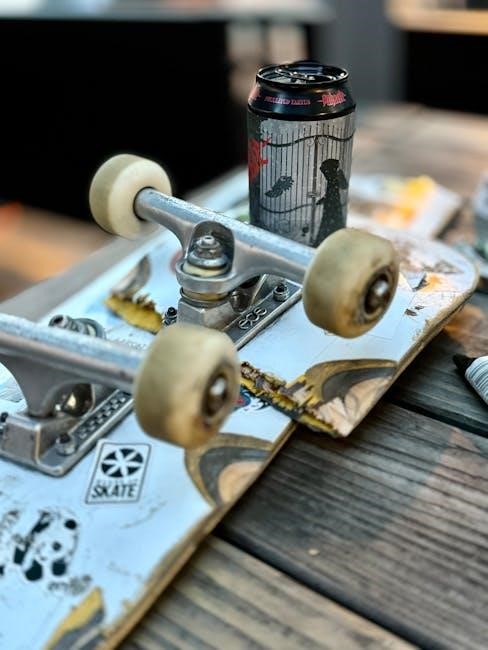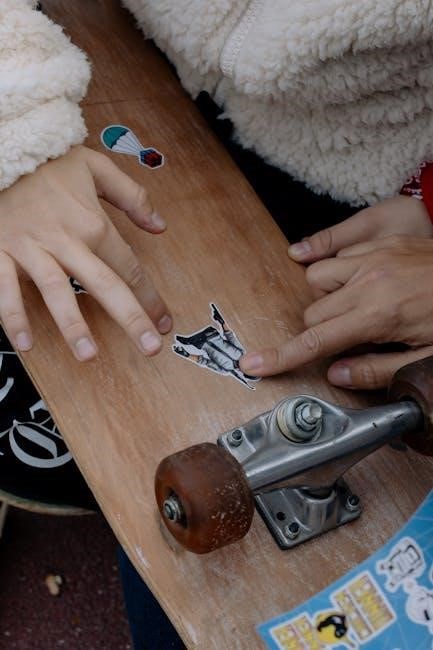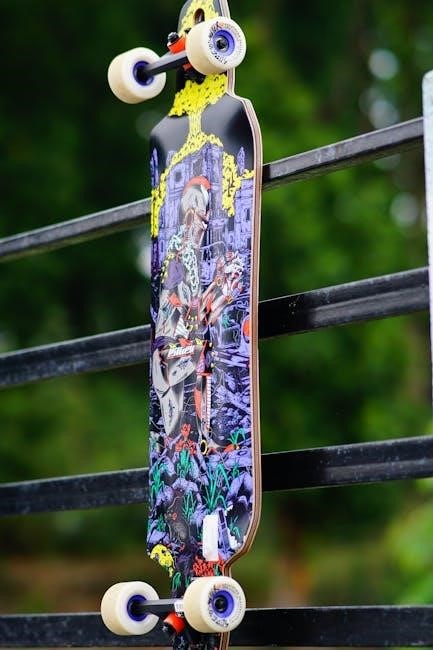
Skateboard trucks are essential components that enable steering and stability. Their T-shaped design holds the wheels and allows for precise control. Understanding trucks is crucial for optimal performance.
1.1 What Are Skateboard Trucks?
Skateboard trucks are T-shaped metal components attached to the skateboard deck, holding the wheels and enabling movement. They consist of an axle, hanger, and baseplate, allowing for turning and stability. Trucks are crucial for steering and balance, with adjustable tightness via the kingpin. They come in various sizes and materials, such as aluminum or steel, to suit different skating styles and preferences. Properly fitted trucks ensure optimal performance and safety for skaters of all levels.
1.2 Importance of Trucks in Skateboarding
Skateboard trucks are fundamental for controlling the board’s movement, enabling turning, and maintaining balance. They connect the deck to the wheels, allowing precise steering and stability. Trucks influence the skateboard’s overall performance, with their size, material, and tightness affecting how the board rides. Properly fitted and adjusted trucks enhance maneuverability, making them essential for both beginners and experienced skaters. Without functional trucks, a skateboard cannot operate effectively, emphasizing their critical role in the skating experience.

Components of Skateboard Trucks
Skateboard trucks consist of the axle, hanger, bushings, kingpin, and baseplate. These parts work together to provide stability, enable turning, and secure the deck to the wheels.
2.1 Axle and Hanger
The axle is the metal rod connecting both wheels, while the hanger holds the axle in place. Together, they form the foundation of the truck, enabling smooth turns and stability. The hanger’s shape and axle’s strength directly impact the board’s maneuverability and durability. Proper alignment and tightness are essential for optimal performance and to prevent damage during rides.
2.2 Bushings and Their Role
Bushings are polyurethane pads that fit between the truck’s hanger and baseplate, enabling smooth turning. They absorb shocks and vibrations, providing stability. Softer bushings offer better grip and easier turning, while harder ones deliver more stability at higher speeds. Properly fitted bushings ensure optimal performance, allowing riders to control the board’s maneuverability and responsiveness. They are a critical component for a smooth and enjoyable skateboarding experience.
2.3 Kingpin and Nuts
The kingpin is a bolt that connects the truck’s hanger to the baseplate, allowing the hanger to pivot and turn. It is secured by a nut that, when tightened, ensures stability and responsiveness. Proper tightening of the kingpin is crucial to avoid loose trucks, which can affect control. The kingpin’s quality and fitment significantly impact the truck’s performance, making it a vital component for precise steering and maneuverability.
2.4 Baseplate and Mounting Hardware
The baseplate is the foundation of the truck, attaching it to the skateboard deck. It is typically made of durable materials like aluminum or steel for strength and stability. Mounting hardware, including screws and bolts, secures the baseplate to the deck. Proper installation ensures a solid connection, preventing movement or instability. The baseplate’s design and fitment directly impact the skateboard’s performance, making it a critical component for both functionality and safety.

Types of Skateboard Trucks
Skateboard trucks come in various types, each designed for specific skating styles. Standard, low, high, and hollow trucks cater to different preferences, ensuring optimal performance and maneuverability.
3.1 Standard Trucks
Standard skateboard trucks are the most common type, offering a versatile and balanced ride. They are suitable for all skating styles, from street to park, and casual cruising. With a medium height and width, they provide stability and maneuverability, making them ideal for a wide range of skaters. Their compatibility with various deck sizes and wheel setups ensures they remain a popular choice for both beginners and experienced riders seeking reliable performance.
3.2 Low Trucks
Low skateboard trucks are designed for technical skating and tricks. Their lower profile enhances stability at higher speeds and makes it easier to perform flip tricks. With a reduced height, they lower the center of gravity, improving control and responsiveness. Ideal for street and park skating, low trucks are favored by experienced riders seeking precision and quick maneuverability. Their compact design allows for better pop and faster turns, making them a top choice for skill-focused skaters.
3.3 High Trucks
High skateboard trucks are taller than standard trucks, offering more ground clearance and a higher ride. They are ideal for carving, cruising, and longboarding due to their enhanced stability at higher speeds. The taller profile allows for easier turning and better leverage, making them popular among larger or older riders. High trucks provide a more relaxed skating experience, though they may feel less responsive for technical tricks. They are perfect for those prioritizing comfort and smooth transitions over precise maneuverability.
3.4 Hollow Trucks
Hollow trucks are lightweight skateboard truck versions, designed to reduce weight without sacrificing durability. They feature hollow axles and kingpins, appealing to skaters seeking easier pop and faster tricks. These trucks enhance maneuverability and responsiveness, ideal for street skating and technical tricks. However, their lighter construction may offer less stability for high-speed riding compared to solid trucks. Hollow trucks cater to advanced skaters prioritizing agility and precision in their performance.

Skateboard Truck Size and Width Guide
Skateboard truck size and width significantly impact performance and stability. Properly matching truck width to deck width ensures optimal maneuverability and control for various skating styles and preferences.
4.1 How Truck Size Affects Performance
Truck size significantly impacts a skateboard’s maneuverability and stability. Narrower trucks enhance agility and responsiveness, ideal for tricks, while wider trucks provide stability and control, better for cruising. Properly matched truck width to deck width ensures balanced performance, preventing issues like wobbling or difficulty in turning. The right truck size optimizes the skater’s experience, whether for technical tricks or smooth rides, making it a critical factor in overall skateboarding performance and satisfaction.
4.2 Matching Truck Width to Deck Width
Matching truck width to deck width ensures optimal performance and control. Trucks that are too wide may cause instability, while too narrow can hinder maneuverability. Generally, truck width should align closely with deck width, with slight variations for personal preference or skating style. For instance, street skaters might opt for narrower trucks for agility, whereas cruisers prefer wider trucks for stability. Consulting size charts from manufacturers can provide precise recommendations, ensuring a balanced setup that enhances the skating experience.
4.3 Common Truck Widths and Their Uses
Common truck widths range from 7.6″ to 8.5″, each suited for specific skating styles. Narrower trucks (7.6″-8.0″) are ideal for street skating, offering agility and quick turns. Medium widths (8.0″-8.25″) provide versatility for all-terrain skating, balancing stability and maneuverability. Wider trucks (8.25″-8.5″) are perfect for cruisers and downhill riders, enhancing stability at higher speeds. Matching the right width to your deck ensures optimal performance and control, tailored to your skating preferences and terrain.

Truck Construction Materials
Skateboard trucks are typically made from aluminum or steel. Aluminum trucks are lightweight and durable, while steel trucks offer greater strength and longevity for heavy use.
5.1 Aluminum Trucks
Aluminum trucks are lightweight, durable, and corrosion-resistant, making them ideal for most skateboarding styles. They provide a smooth ride and are easier to maneuver, especially for tricks and street skating. Many top brands offer polished or forged aluminum options, enhancing strength and aesthetics. Aluminum trucks are a popular choice due to their balance of performance, weight, and affordability, making them suitable for both beginners and experienced skaters.
5.2 Steel Trucks
Steel trucks are heavier and more durable than aluminum, offering exceptional strength and stability. They are ideal for heavier skaters or those seeking a solid, long-lasting setup. While less common today, steel trucks provide a rigid feel that some skaters prefer for certain styles of skating. Their durability makes them a reliable choice, though they may lack the lightweight responsiveness of aluminum trucks. Steel trucks remain a niche option for skaters prioritizing strength and longevity over weight reduction.
5.4 Hollow vs. Solid Trucks
Hollow trucks feature a hollow axle and kingpin, reducing weight for lighter, more responsive performance. They are favored by experienced skaters for better maneuverability and speed. Solid trucks, made from a single piece of metal, are heavier and more durable, offering stability and strength. Hollow trucks are ideal for tricks and fast skating, while solid trucks suit rough skating or heavier riders. Both designs cater to different skating styles and preferences, balancing weight, strength, and performance.

Bushings and Their Impact on Ride
Bushings are crucial for controlling the tightness of your trucks, affecting how your board turns and feels. Softer bushings offer better turning, while harder ones provide stability.
6.1 Hard vs. Soft Bushings
Hard bushings provide stability and are ideal for heavier skaters or those seeking control at high speeds. Soft bushings offer flexibility, making turns easier and suitable for lighter riders or carving. Hard bushings resist compression, while soft ones compress easily, allowing smoother transitions. The choice depends on personal preference, skating style, and weight. Hard bushings deliver a more rigid ride, while soft bushings enhance maneuverability, making them perfect for street or park skating.
6.2 How to Choose the Right Bushings
Choosing the right bushings is crucial for optimal truck performance. They determine how your board turns and remains stable. Consider your weight and skating style—hard bushings offer stability for heavier riders or high-speed skating, while soft bushings provide easier turning for lighter skaters or carving. Ensure the bushings’ size and shape match your trucks for proper fit. Personal preference and riding style also significantly impact the choice, ensuring the best ride experience.
6.3 Replacing and Tightening Bushings
Replacing and tightening bushings ensures smooth performance and prevents wear. Start by removing the kingpin nut, then the old bushings. Insert the new ones, aligning them properly. Reattach the nut and tighten gradually. Avoid overtightening to prevent binding. Use a skate tool for precise adjustment. Regular checks and maintenance keep the trucks responsive and extend their lifespan, ensuring optimal control during rides.
How to Mount and Install Skateboard Trucks
Mounting trucks involves attaching them to the deck using hardware. Align the baseplate with the deck’s holes, insert screws, and tighten securely. Proper installation ensures stability and control;
7.1 Tools Needed for Installation
Installing skateboard trucks requires a few essential tools: a skate tool (for kingpin and axle nuts), an Allen wrench (for mounting hardware), and a screwdriver (for deck screws). A socket wrench may also be useful for tighter bolts. Pliers can help with stubborn parts, while a ruler ensures proper alignment. Optional tools include a power drill for pre-drilling holes and safety gear like gloves. Gathering these tools beforehand ensures a smooth, efficient installation process and prevents delays.
7.2 Step-by-Step Mounting Guide
Begin by placing the trucks onto the deck, ensuring they are centered and aligned with the deck’s bolts. Mark the mounting holes using a pencil or marker. Next, drill pilot holes for the screws to avoid splitting the wood. Insert the mounting hardware through the deck and secure the trucks using the provided bolts. Tighten evenly to prevent uneven stress. Finally, attach the wheels and bearings to the axle, ensuring proper alignment and torque for a smooth ride.
7.3 Tightening the Kingpin and Axle
Use a skate tool with a 9/16-inch socket for the kingpin and a 1/2-inch socket for the axle nuts. Tighten the kingpin nut firmly, but avoid over-tightening, as this can damage the bushings. Next, tighten the axle nuts evenly to secure the wheels, ensuring they still spin freely. Check the tightness periodically to maintain stability and performance. Proper tightening ensures safe and responsive steering, while over-tightening can restrict movement. Keep your trucks adjusted for optimal skating.

Skateboard Truck Buyer’s Guide
Choosing the right skateboard trucks involves considering size, height, and construction materials. Research top brands and compare features to find the best fit for your riding style and budget.
8.1 Key Considerations
When buying skateboard trucks, prioritize size, height, and durability. Ensure the truck width matches your deck for stability. Consider your skating style—street, park, or cruiser. Materials like aluminum or steel impact weight and strength. Bushings hardness affects turning responsiveness. Budget and brand reputation are also crucial factors. Always check compatibility with your current setup to avoid sizing issues and ensure optimal performance.
8.2 Top Brands and Their Features
Independent Trucks are known for their durability and versatility, offering a wide range of sizes. Krux Trucks feature forged aluminum for added strength and a sleek design. Royal Trucks blend style with performance, catering to diverse skating styles. Tensor Trucks are lightweight and ideal for technical skaters, while Ace Trucks offer unique geometry for precise control. Each brand specializes in specific skating needs, ensuring there’s a perfect fit for every rider’s preferences and performance demands.
8.3 Budget vs. High-End Trucks
Budget trucks are ideal for beginners, offering affordability without compromising basic functionality. They are usually made of durable materials but may lack advanced features. High-end trucks, like those from Independent or Tensor, use premium materials for superior performance, durability, and customization. While budget options are perfect for casual skating, high-end trucks are designed for professional skaters seeking precision and longevity. Balancing budget and quality ensures the best fit for your skating level and investment.
Maintenance and Care Tips
Regular cleaning and lubricating skateboard trucks prevent rust and wear. Inspect bushings and tighten bolts to ensure smooth performance and longevity of your skateboard setup.
9.1 Cleaning and Lubricating Trucks
Regularly clean skateboard trucks with a soft brush and mild detergent to remove dirt and grime. Apply silicone-based lubricant to moving parts like the axle and kingpin. This prevents rust and ensures smooth turning. Avoid over-lubrication, as it can attract dust. Use a cloth to wipe off excess lubricant. Cleaning and lubricating trucks every few weeks extends their lifespan and maintains optimal performance. Always inspect for wear during maintenance to catch issues early.
9.2 Replacing Worn-Out Parts
Replace worn-out truck parts promptly to maintain performance. Inspect bushings, kingpins, and axles for signs of wear. Use a skate tool to remove old parts and install new ones. Ensure all nuts and bolts are tightened securely but avoid over-tightening. Replace bushings if they show cracks or lose their shape. Lubricate new parts before reassembly. Regular replacement prevents further damage and keeps your skateboard running smoothly. Always refer to manufacturer guidelines for specific replacement instructions.

Common Mistakes to Avoid
- Using incorrect truck size for your deck width.
- Over-tightening or under-tightening the kingpin and axle.
- Ignoring worn-out bushings or kingpins.
- Choosing the wrong truck height for your skating style.
Refer to size guides and manufacturer recommendations to avoid these errors.
10.1 Incorrect Truck Size
Using the wrong truck size can significantly affect your skateboard’s performance. Trucks that are too wide or too narrow for your deck can lead to instability and poor turning ability. Always match your truck width to your deck’s width for optimal control and maneuverability. Refer to size guides to ensure compatibility and avoid common issues like reduced stability or difficulty in navigating smoothly. Proper sizing enhances both safety and the overall riding experience.
10.2 Over-Tightening or Under-Tightening
Over-tightening skateboard trucks can make the board difficult to turn, while under-tightening may cause instability. Proper tightness ensures smooth movement and safety. Use a skate tool to adjust the kingpin and axle nuts. Avoid excessive force, as this can damage components. Regularly check and adjust the tightness to maintain optimal performance and prevent potential hazards while skating.

Upgrading Your Skateboard Trucks
Upgrading your skateboard trucks enhances performance and personalizes your ride. Consider new bushings, axles, or kingpins for better maneuverability. Choose components that match your skating style and needs.
11.1 When to Upgrade
Upgrade your skateboard trucks when you notice wear and tear, such as rusty axles or worn bushings, affecting performance. If your trucks feel loose, wobbly, or make turning difficult, it’s time to consider new ones. Additionally, upgrading can enhance your skating experience by improving stability, maneuverability, or speed. If you’re switching skating styles or preferring a lighter setup, such as hollow trucks, an upgrade ensures better compatibility with your riding needs and preferences.
11.2 Choosing the Right Upgrade
When selecting an upgrade, consider your skating style and preferences. For street skating, durable trucks with solid construction are ideal. For cruising, lighter options like hollow trucks offer better maneuverability. Match the truck size to your deck width for optimal performance. Harder bushings provide stability at higher speeds, while softer ones improve turning. Top brands like Independent or Krux offer high-quality options. Budget-friendly choices are available, but investing in high-end trucks ensures longevity and superior ride quality. Research reviews to find the best fit for your needs.

Troubleshooting Common Issues
Common issues include wobbly trucks, difficulty turning, or excessive wear. Regular maintenance, like tightening bolts and replacing worn bushings, can resolve most problems effectively and quickly.
12.1 Wobbly or Loose Trucks
Wobbly or loose trucks are common issues that affect stability. They often result from loose kingpin or axle nuts, worn-out bushings, or misaligned hardware. Regularly inspect and tighten these components using a skate tool.
If the problem persists, replace worn bushings or realign the trucks. Over-tightening can cause damage, so ensure a balanced fit. Proper maintenance ensures smooth performance and prevents further damage to the trucks and deck.
12.2 Difficulty Turning
Difficulty turning can occur due to overly tight bushings or improper alignment. Ensure bushings are not too hard and are properly seated. Misaligned trucks may cause uneven turning, so adjust them to match the deck’s center. Regularly clean and lubricate moving parts to maintain smooth movement. If issues persist, consider replacing worn-out components or consulting a professional. Proper truck setup ensures better maneuverability and responsiveness.